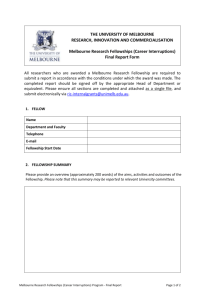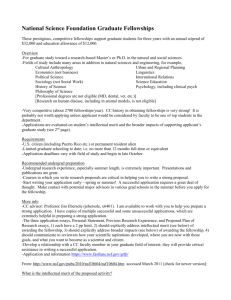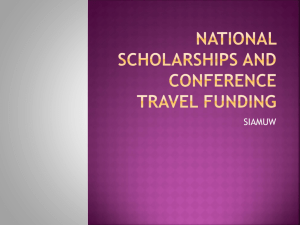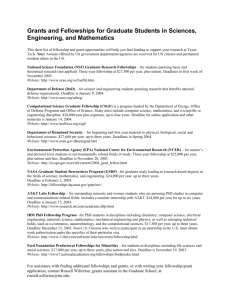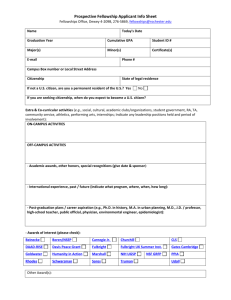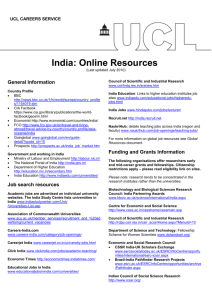Overview: Finding Fellowship Funding…
advertisement
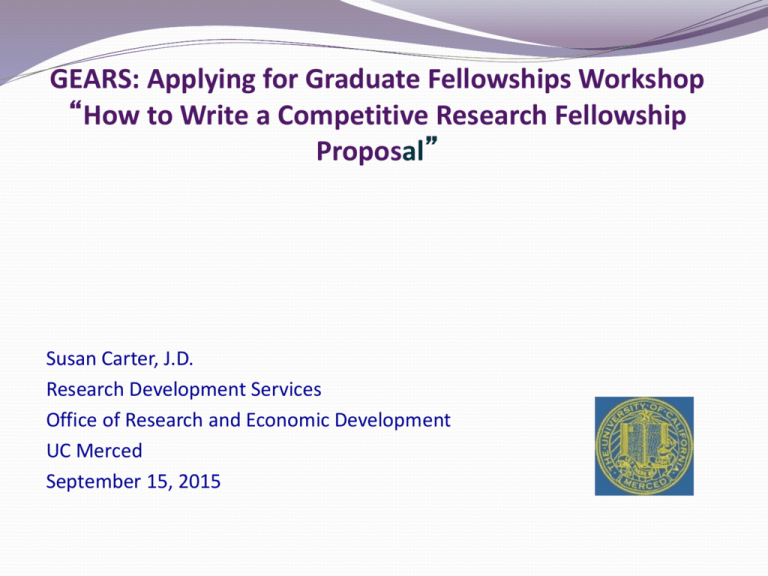
GEARS: Applying for Graduate Fellowships Workshop “How to Write a Competitive Research Fellowship Proposal” Susan Carter, J.D. Research Development Services Office of Research and Economic Development UC Merced September 15, 2015 Overview: Finding Fellowship Funding… FIRST and FOREMOST: discuss sources of support for your field with your faculty advisor/mentor . Networking: ask your peers, colleagues, speakers, and others about their funding sources and knowledge, especially if they work on projects similar to yours. Scholarly literature: check acknowledgements in relevant professional literature to identify funders interested in your topic area. Databases: search funding agency websites and publications and electronic databases for relevant opportunities. Overview: Sources of Fellowship Funding Federal Agencies The six Biggest Players are: NIH, DOE, DOD, NSF, NASA and USDA National and regional non-profits and Foundations (e.g. American Cancer Society, Autism Speaks, American Foundation for AIDS Research/amfAR); State funded programs (e.g. California Breast Cancer Research Program, California Institute for Regenerative Medicine, California Program on Access to Care, California HIV/AIDS Research Program); Private Companies ; Professional Associations; Institution – based. Overview: Types of Graduate Fellowships Portable Fellowships You compete directly for the award. You apply to agency and sometimes can take it with you (although some agencies tie it to the institution). Examples: NSF Graduate Research Fellowship Program, National Defense Science and Engineering Graduate Fellowship, EPA STAR Fellowships, NIH Training Fellowships. See http://www.gradschools.com/article-detail/graduate-fellowships1676#Federally_Funded_Portable_Fellowships (note: last updated 8/2015) And http://graduatedivision.ucmerced.edu/financial-support/externalfunding 4 Types of Graduate Fellowships, contd. Institutional Awards Students selected by department, program or faculty. May be based at UC Merced or at another institution. Examples: NSF IGERT and NRT, NIH Institutional Research Training Grants (doctoral and post-doc). May be internally funded: see http://graduatedivision.ucmerced.edu/financialsupport/internal-funding Overview: Applying for Fellowship Research Funding Research and fellowship funding programs are highly competitive. Start looking early! Plan on several months or more to prepare your proposal. Most searches and applications are web-based. Application guidelines vary among agencies and opportunities. Contact UC Merced Grad Division for help 6 Finding Funding Opportunities: What can you learn from the Agency’s Website? A description of their research mission, goals, programs. Opportunities to sign up for email lists, including announcements of new funding opportunities. Budget information, including funding rates for various programs, mechanisms and disciplines. e.g. NIH RePORT: http://report.nih.gov/ Org charts. (helpful to figure out funding areas and who to email or call!) Some programs to look at: Ford Foundation Fellowship Program: http://sites.nationalacademies.org/pga/fordfellowships/index.htm DoE Computational Science Grad Fellowship: http://www.krellinst.org/csgf/ Usually due in January National Defense Science and Engineering Graduate Fellowship Program (NDSEG): http://www.asee.org/ndseg three years tuition and fees, a monthly stipend, and medical insurance. Includes biosciences and behavioral sciences. Usually due in December; should open any day (was due 9/1/15). Finding Funding: COS PIVOT Community of Science (COS) Pivot: Is a multi-disciplinary searchable funding opportunities database Helps identify potential collaborators Matches faculty with funding opportunities Represents over 40,000 private, federal, and international funding opportunities 9 SETTING UP A PIVOT ACCOUNT Need account in order to: Access COS Pivot from off-campus Save search results Manage your Home page (dashboard) Receive funding alerts www.pivot.cos.com Click on Sign up, written in blue print on the top right corner 10 QUICK GUIDES & SUPPORT You Tube Pivot Channel: http://www.youtube.com/user/ProQu estPivot Or RDS at rds@ucmerced.edu 11 Focus on the NSF Graduate Research Fellowship Program FOCUS on the NSF GRFP: National Science Foundation (NSF) Graduate Research Fellowship Program (GRFP) Recognizes and supports outstanding graduate students in the relevant science, technology, engineering, and mathematics (STEM) disciplines pursuing research-based master’s and doctoral degrees. Includes the social sciences. Both applicant’s proposed research and graduate study must be in a recognized NFS STEM field (See RFA for fields of study); can be interdisciplinary. • Program Website: http://www.nsfgrfp.org/ Most Recent Call for Applications : http://www.nsf.gov/pubs/2015/nsf15597/nsf15597.htm 13 Overview: NSF GRFP 2015 Awards 2000 Awards (same as 2013 and 2014); success rate about 12% (source: NSF). 456 baccalaureate institutions. 53% women, 25% underrepresented minority groups. See if your friends made the list at: https://www.fastlane.nsf.gov/grfp/AwardeeList.do?method=l oadAwardeeList 14 NSF GRFP Due Dates Geosciences, Life Sciences: October 26, 2015 CISE, ENG, Materials Research: October 27, 2015 Psychology; Social Sciences; STEM Education and Learning: October 29, 2015 Chemistry; Mathematical Sciences; Physics and Astronomy: October 30, 2015 Focus on NIH Training Fellowships Overview of NIH Fellowships Opportunities include both Institutional (T series) and Individual (F series) awards. In 2014 average overall success rate for F31 Fellowships was 28.2% Success rates varied by Institution; e.g. NIEHS 50% More Analytical information at: http://grants.nih.gov/training/outcomes.htm#DataStatistics See also the NIH Training Kiosk: https://grants.nih.gov/training/F_files_nrsa.htm Focus on NIH, contd. Ruth L. Kirschstein National Research Service Awards for Individual Pre-doctoral Fellows (PA-14-147; F31) Next due date: December 8, 2015 Purpose: to provide up to five years support for promising candidates for research training which leads to the PhD or equivalent in the biomedical, behavioral, or clinical sciences. http://grants.nih.gov/grants/guide/pa-files/PA-14-147.html Up to five years; typically two to three. 18 Pre-doctoral fellowships to promote diversity Ruth L. Kirschstein National Research Service Awards for Individual Pre-doctoral Fellowships to Promote Diversity in Health-Related Research (PA-14-148) Next due date: December 13th. Purpose: to improve diversity of the health-related research workforce by supporting the training of predoctoral students from underrepresented groups. Provides up to five years of support leading to PhD.; typically two to three http://grants.nih.gov/grants/guide/pa-files/PA-14-148.html Who is eligible? A. Individuals from underrepresented racial and ethnic groups; B. Individuals with disabilities; C. individuals from socially, culturally, economically, or educationally disadvantaged backgrounds that have inhibited their ability to pursue a career in healthrelated research. NOTE: Institution must certify eligibility. What Makes a Fellowship Proposal Competitive? Competitive research fellowships: Don’t lose them up front: Introductory sections are clear and straightforward. Put the most important information in the first sentence or two (for both research plans and personal statements)! Are tailored to the goals of the agency. Are ‘doable’: the research will be feasible and realistic within the timeframes stated and with the resources available. Do not promise too much: “Balance ambition with sense” (Howard, NSF Astronomy Div.) (Note: especially for fellowships). Competitive fellowship proposals, contd.: Demonstrate knowledge of subject area and literature. A good literature search is a must. Contain new and original ideas. Have a succinct, focused project plan with appropriate methodology. Are focused on achieving the aims and objectives; are not a patchwork of unrelated tasks. Address the Big Picture; clearly state why the proposed research is important, significant, and what it will contribute to the field. Competitive Training Proposals and Fellowships: Clearly describe the training environment. Demonstrate how environment will support and further fellows’ training research and career and include an excellent career development plan. Reflect quality of the Advisor/Advisee relationship. Include specific plans to evaluate the trainees progress. Some questions to think about: 5-10 year plan or ‘horizon’. What are your personal short and long term research goals? What are your career goals? What should they invest in you? Why are you a ‘fit’ with the opportunity? More questions to think about… What are the expected outcomes of your research? What hypothesis will you test? What approach will you take ? How is your research plan innovative? What training opportunities does the research provide for you? What are you and your Advisor/research group’s competitive advantages? Are you (and your Avisor/research group and collaborators) qualified to study this area? Does your institution have the resources to do the proposed work? A few general tips….. State things simply in common terms, and define your terms clearly if you must use nonstandard language. Don’t be afraid to show your passion and your motivation! But don’t tell your life story! 27 More tips… Take the hint: If they give you an ‘outline’, follow it! Use informative subheadings. If there is a gap in your expertise address it. Address how you will deal with the inevitable ‘pitfalls’ in your research plan… Include relevant, quality graphics: many reviewers are visual thinkers. A few more tips… Answer the questions you would have if you were reviewing the proposal. Include a timeline. Ask your advisor and other faculty and graduate students if you can read copies of their successfully funded proposals. Ask them to read yours. Ask an educated ‘lay’ person to read and comment on your proposal. Ask another person to proofread and edit the final draft. A few submission tips…. Complete the application in full. Note if something is not applicable on the application. Do not leave items blank. Follow directions. Have a self-imposed deadline two weeks prior to the actual due date. Use this as proofreading time. Carefully proofread the entire application. Research Development Services Contact: Susan Carter, J.D. Research Development Services Office of Research Telephone: (209) 228-4695 scarter3@ucmerced.edu http://researchdev.ucmerced.edu/
